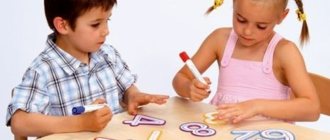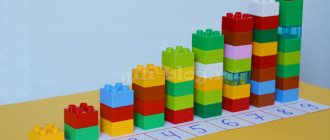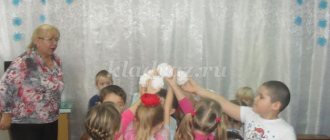Distinguish between "left" and "right"
For studying in general and so as not to confuse the concepts of “clockwise” and “counterclockwise” as well.
Have a general understanding of time
We explain to the child the concepts of “yesterday”, “today”, “tomorrow”; "past present Future"; “morning”, “day”, “evening”, “night”, “day”. Often children themselves associate time with a specific event: “in the morning I did exercises”, “at lunch I ate soup”, “before going to bed I brushed my teeth”, etc. Therefore, when explaining the above concepts, it is best for a parent to tie specific events to them.
Correct your child carefully if he makes mistakes somewhere. It is important that he does not develop a false understanding of time.
Have you successfully completed the preparatory stage? Now we can teach the child to understand time using a clock with arrows.
How to teach to understand and tell time
- Teach your child to sense time . Learning to tell time is quite difficult. In kindergarten, children sense rather than understand the time of day. Woke up “in the morning”, at the end of the day - “evening”. In a few years, the understanding of time and the possibilities for measuring and indicating time will develop further and more deeply. At school age, children can tell time to the nearest second on both digital and analog clocks with arrows.
- Give your child a watch as a toy . Children love to pretend to play everyday situations. Once they've learned a little about the concepts of time and clocks, it's a good idea to let them play with clocks. This could be an old clock that no longer works, or a special play/learning clock.
- Be clear about the time . As your child gets older and learns to tell time a little, you can also refer to the clock in conversations about time. “You must finish breakfast at a quarter to nine because classes start at half past eight.” Or: “You can’t watch TV until three, so you’ll have to wait another half hour.”
- Start in a clockwise direction . First an hour, then half an hour. This is where the game clock comes in handy. Keep the minute hand at 12 and turn the short hand. Show your child that the hand points to a number on a clock and that this number represents the hour. Let the child turn the hands himself until he learns to count and understand the clock.
- Then tell what the minute hand does . Limit yourself to 30 minutes at first. Then show it every quarter of an hour. And then minutes. Since there are 60 minutes in an hour, it is important that your child can already count to 60. One of the hardest things to understand when learning how to tell time is understanding exactly how the long and short hands relate to each other. For this reason, it is also useful to start at the half and quarter hours because you can clearly see how far the hour hand is moving toward the next hour. The most difficult moments are when the hour hand disappears behind the hour hand, for example, five minutes past one.
- Always at hand. Practice makes perfect. Give your child his own watch and ask him regularly what time it is.
- Explain the difference between telling time using a hand clock and a digital clock . Digital watches are the most natural thing in the world for modern children. After all, all our devices display time digitally: computers, smartphones, tablets, the oven in the kitchen. Since digital watches don't have the problem of hands, they make it relatively easy to read the time. “It’s seven thirty-six.”
- Teach your child to estimate time. Just because a child can tell time correctly does not mean he has mastered the entire concept of “time.” It is important that your child learns to appreciate how quickly time passes and how much time he spends on certain activities. Can you bake another cake if you have to go to football practice in an hour? How long is the bike ride to grandpa and how much time do you have? How long does it take you to get ready for school in the morning? Don't assume that a child already knows such things if he can tell time, because these two things are not always in sync in their development.
Basic principles of teaching time
Parents are first advised to start introducing the baby to the concepts of “morning”, “lunch”, “evening” and the seasons. It is advisable that he knows how to count to 100 and be able to add at intervals of “5”. It is better to conduct classes in a playful way, as this promotes better perception of information. With such training, the child will not need to be forced; he will be interested in learning something new while playing.
Advice!
Parents should prepare some teaching materials in advance, because with the help of visualization it will be easier for children to perceive the process of time. Funny and bright illustrations will remain in their memory for a long time.
First, the baby is introduced to the future, present and past tense. You can give common life examples:
- Yesterday it rained heavily - that's the past;
- now you are riding a bike - this is the present;
- Tomorrow is a day off and we will go to the park - this is the future.
We need to help the child navigate the seasons and know their main differences.
For example, it’s snowing outside - winter has come. When the grass turns green and the trees bloom, spring has come. In the summer you can swim in the river and eat ice cream, and with the onset of autumn the leaves turn yellow and fall off, and the birds fly away to warmer climes.
After getting acquainted with the seasons, they begin to study the names of the months. The child must remember which months belong to each season. Then tell him that a month consists of a certain number of days (28, 29, 30, 31) and weeks. Each week includes seven days.
See also:
How to teach a child to read syllables at home at 5-6 years old?











